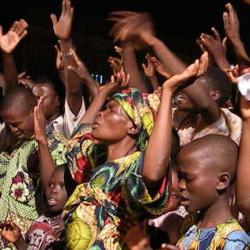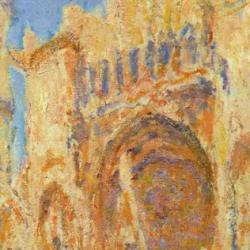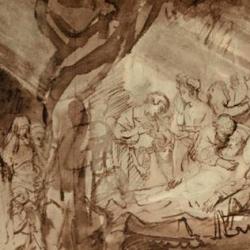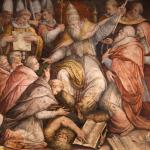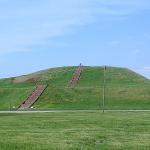God created two different kinds of land creatures, which are identified with two different sorts of names in the Old Testament. Wild animals are classified as “living things” (chayyah), while domesticated animals are classified as “cattle” (behemah). This is a division built into the original creation, and does not have to do with sin. Sin may affect the behavior of different animals, but already at the beginning God created different sorts of animals, classified by their nearness and friendliness to human beings. Cattle are domesticated, and some creatures are created as domesticated creatures; beasts are wild, created outside of the human world. Beasts may be tamed at some point, but they are not tamed at the beginning. The visions of Isaiah, where the lion lies down with the calf and the ox and the bear graze together, are eschatological, not Edenic visions.
Cherubim combine the two sorts of beasts that we find in the creation. Cherubim have an ox face and a man face, the faces of human life and domesticity. But they also have faces of a lion and an eagle, two wild creatures. Fittingly, cherubim are guardians of boundaries, facing into the human world on the one hand and facing out to the wilds on the other. In the different functions of the cherubim, we can see two different aspects of the biblical theology of animals.
When the cherubic figures are first introduced in Revelation 4, they are in the midst of the ??????, actually forming the throne on which the Lord is seated. The cattle-beast cherubim form a throne. There is perhaps a multiple pun in the background of this association of cherubim and thrones. “Cattle” translates the Hebrew behemah, which is related punningly, if not etymologically, with the word for “high place,” bamah. Cherubim form the “high place” on which the Lord is enthroned. And that is perhaps punningly related to a Greek word for throne, bema, “judgment seat” (Matthew 27:19; John 19:13; Acts 18:13, 16-17; Romans 14:10; 2 Corinthians 5:10).
Animals form a “high place” for human beings; as the cherubim form a throne for Yahweh, so cattle form a throne for human beings. That is literally true in the sense that human beings ride on the backs of animals, “enthroned” on saddles, often as finely decorated as thrones. A king who was not “enthroned” on his horse when threatened would soon lose the throne in his palace. It is metaphorically true insofar as ancient human beings depended on the produces and work of animals. Cattle form the throne on which human civilization rests.
Insofar as cherubim are beasts rather than cattle, they face the wild (they are “beasts of the field,” not in the garden) and serve as guardians, first of the garden and then of the sanctuaries of Israel. They turn their fangs (lion) and talons (eagle) toward intruders and enemies. Cherubim form a ring around the sanctuary.
This too has a human analogue. David was the “lion from the tribe of Judah,” an external guardian of the sanctuary as the priests were the internal guardians. Lions and eagles are unclean beasts, representing Gentiles, and therefore represent the proper position of Gentiles: External guardians of God’s house, facing Yahweh’s enemies. In Daniel 7, four imperial beasts arise from the Gentile sea so that they can form a protective cordon around Israel.
From the beginning, beasts failed in this vocation. Instead of serving as a guardian of the garden-sanctuary, the serpent – the craftiest beast of the field – attack Eve and seduces her (cf. 2 Corinthians 11). Adam fails in his role as protector, and this initiates a theme of bestiality that runs through the Bible.
Under the law, animals that attack human beings are put to death. They become serpentine when they attack humans, and, like the serpent, their heads must be crushed. Gentile beasts can also turn against Israel and attack and devour them. Yahweh permits the beasts to attack Israel, but ultimately intervenes to deliver them and crush the beasts.
The most explicit and gruesome portrait of spiritual bestiality comes from Ezekiel 16, where Judah/Jerusalem is depicted as an insatiable whore, spreading her legs to everyone who passes, men with penises like donkeys and seminal issues like horses. She is sleeping with the nations, and taking her sexual pleasures from the idols of the nations. Here Judah/Jerusalem is worse than Eve; she is not deceived by the beasts, but willingly gives herself to them. The only result can be bestial children, half-man and half-animal. When Judah/Jerusalem sleeps with the bestial nations, she gives birth to false cherubs.
Jesus places Himself between the beast and the bride, and, following His lead, Paul proves himself a faithful Adam, jealously protecting the virgin church of Jesus against the seductions of serpentine false teachers (1 Corinthians 11:1-3) and fighting the wild beasts at Ephesus who prey on the church (1 Corinthians 15:32). Pastoral care is, for Paul, beast-taming.
(Most of this is drawn from a lecture by James B. Jordan on Revelation 13.)






